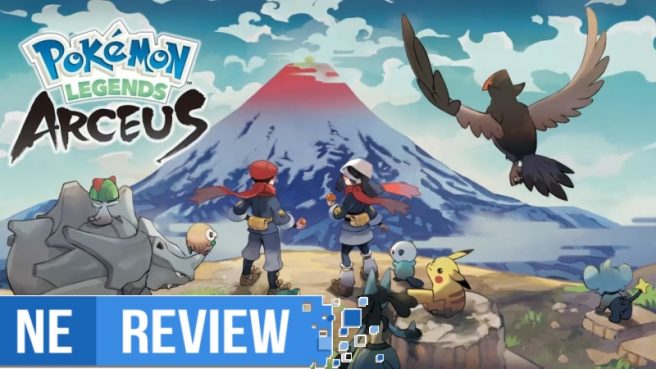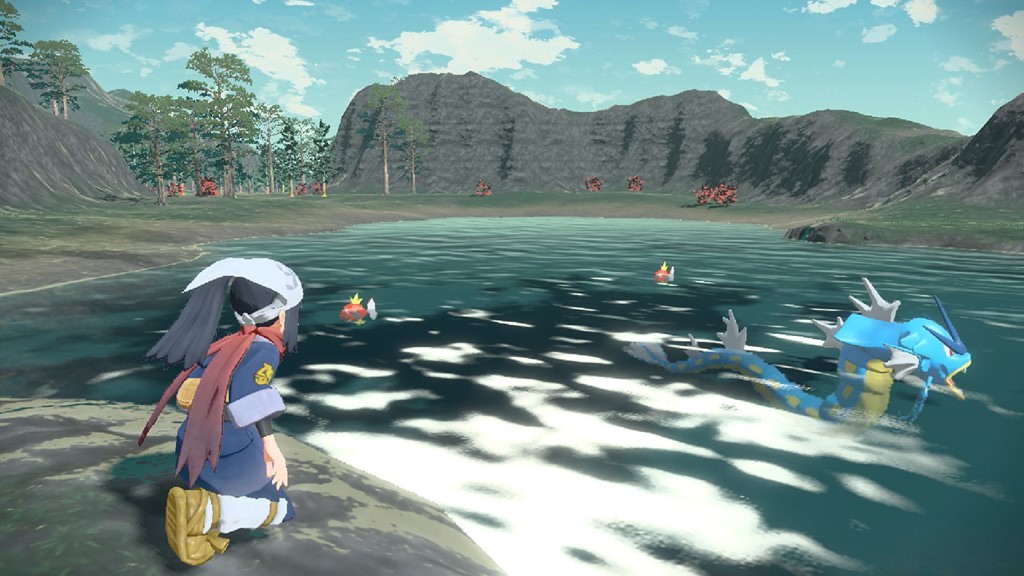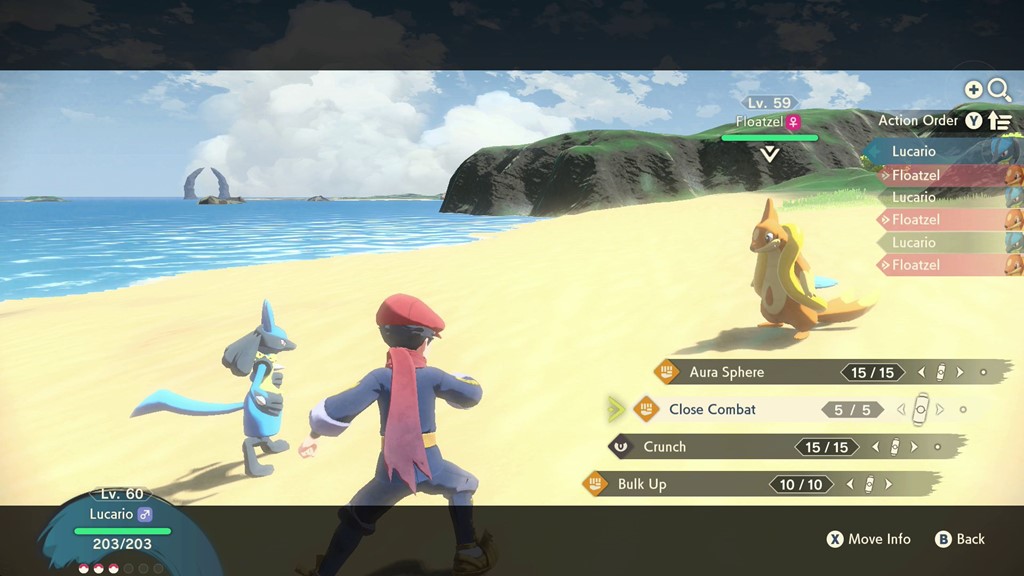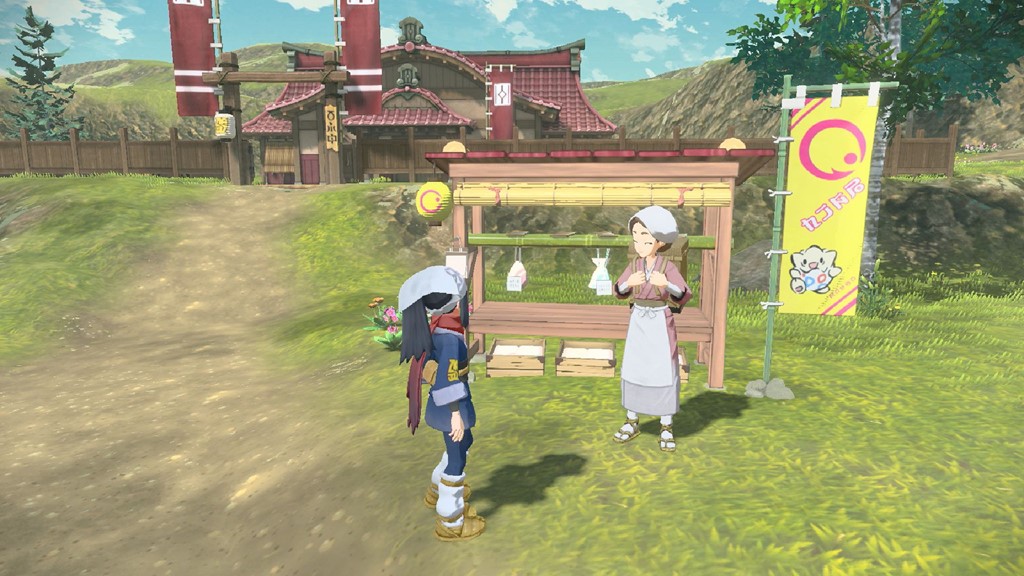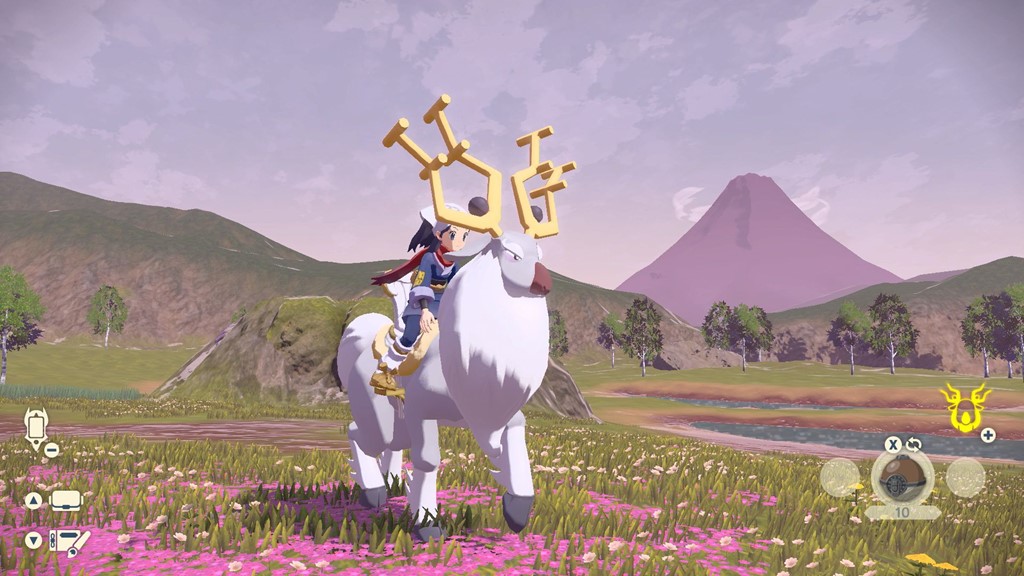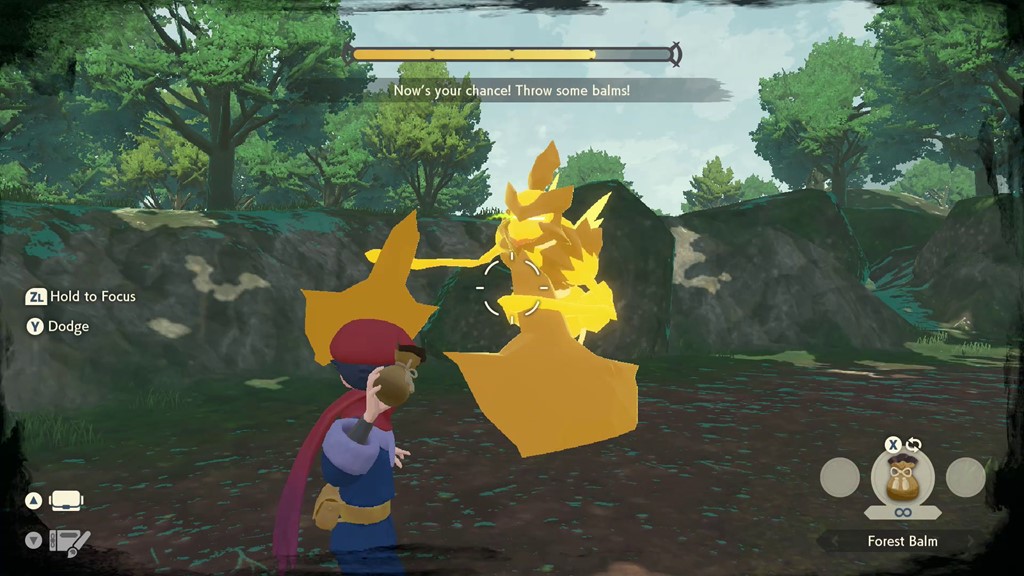[Review] Pokemon Legends: Arceus
System: Switch
Release date: January 28, 2022
Developer: Game Freak
Publisher: Nintendo
The Pokemon games have always been traditionally known for their turn-based “catch ’em all” mantra that sees a trainer take on a new adventure set in a region with many different types of creatures, attaining badges and friends along the way before making it to the Pokemon League and inevitably becoming champion. For over 25 years now this has been a steady formula with each new generation that has been consistently released in two separate versions containing different Pokemon in each, with sometimes a third tagged-on entry, and has also brought with it many new spinoffs to take Pokemon into a different direction. However, nothing has ever been done so drastically different as it has now with Pokemon Legends: Arceus. For a formula that has become tried with little known innovation outside of debut generations on each new platform (despite consistent fun) from entry to entry, this new Switch game reinvents the wheel of what Pokemon has become and can be moving forward in the most exciting way possible. It’s not just a matter of catching them all as a personal goal, but it’s also become a gameplay element that incorporates research into it as well.
Without even having to play the game, one can already tell that Pokemon Legends: Arceus is aiming to do new things from the get-go. The game provides a single experience that can be enjoyed by all rather than a dual release separating some Pokemon availability, the beautiful illustration that does more than place the version’s legendary Pokemon on the cover on a mute background, and the emphasis of world exploration that actually feels rewarding and at a player’s pace rather than mandatory for the sake of being “the very best like no one ever was”. Its messaging, art direction, music, and overall structure has changed drastically, yet the Pokemon we’ve grown to know and love is still very much in full-effect here, only with a much needed update and revision that breathes new life into the series.
This isn’t just about catching them all – it’s about seeking them out and getting to understand their personalities, habitats, and more through your research, which would also inevitably require you to attain them in various fashions. In ways it can feel like a glorified Safari Zone experience with different biomes, but really getting the ability to get up close and defend yourself using your mobility, berries, and any other means of survival gives that extra layer of battling that doesn’t just always consist of creature vs creature gameplay. Everything about the region of Hisui – regardless of its poor technical performances and graphical misfortunes – does well to make you feel like you’re in an age-old time period that shows a Sinnoh that once was. Seeing structures like the Temple of Sinnoh in all its glory before the dilapidated version we’ve come to know from it in Diamond and Pearl as well as other structures, hieroglyphics, ancestors of characters, and more provide a lot of jaw-dropping and interesting moments for players that have been with the series for quite some time now.
Jubilife Village is where you’ll begin your journey and spend the bulk of your time coming back to as a sort of hub for everything you need on you excursions from biome to biome in Hisui, not too different from how Monster Hunter is set up. While not a particularly big village, there’s enough to see and do here from the myriad sidequests and wide array of townsfolk that you’ll happily be coming back to take a breather and get things in order before heading back again. This is incredibly important as sometimes hub worlds can feel like a boring way to do a more interactive level select, but in Pokemon Legends: Arceus you’ll spend just as much time in Jubilife Village going through cutscenes, conducting quests, upgrading, organizing, crafting, and more just as you would in the various areas of Hisui. The game makes sure to give importance and significance to Jubilife Village, and this is emphasized even more as throughout the game you’ll begin to see people who were initially afraid of Pokémon start to become accepting of them as they populate the village over time through understanding and the feeling of having a genuine partner to help around the place. What starts out as a small village ends up growing vastly thanks to the help of Bidoofs, Gravelers, Buizels, and other Pokemon that make their way either into the village or into the hearts of townsfolk through other quests you’ll experience both in and out of it.
I do wish, however, that the town would come a little more to life than just simply switch NPC placements with each time of day (such as making some people stay in their houses during the day and others coming out or standing somewhere else at night). Just about everyone stands around in a fixed position, with little no movement, and that is usually a big drawback for me in an RPG setting, especially in a town, village, or city that’s meant to be bustling with activities and community involvement. The only real show of lively animation is a guy by the farm that chops wood and stops to look at you if you get close before continuing on again. This sort of dynamic interaction I expect more from in games these days rather than mannequins that occasionally blink.
Outside of the village, Hisui is your playground from the snowy peaks of Alabaster Icelands to the volcanic and oceanic views of Cobalt Coastlands. Each area within the region is clearly distinct from one another, containing specific Pokemon dwelling in each with the occasional crossover types that can handle numerous climates. At first, you’ll mainly be running around with an unseen stamina gauge being wary of water (or else you’ll drown) and steep cliffs, but eventually as you are given the Celestica Flute you’ll be able to traverse just about every type of terrain possible with ease and little worry as you progress through the game. Wyrdeer helps you cover vast amounts of land with high running speeds and leaps, Ursaluna helps to track hidden objects underground or lost items, Sneasler can help climb mountainsides and bodies of rock that are difficult to get up to, and Braviary takes to the skies to fly around wherever you’d like and get a better bird’s eye view of things. The best part about all of these forms of travel is that not only can they be seamlessly switched to upon at a moment’s notice with a button press, but they also provide an immediate prompt whenever you’re in a situation that calls for it as to not have to use the directional buttons to get to the icon of the Pokemon you need. If you’re falling from a high point and are plunging to what will certainly make your character black out, you can simply tap A to spawn Braviary and immediately be piloting it even if your selection was on Wyrdeer. If you’re up against a steep cliff, tapping A will instantly bring up Sneasler, and the rest continues as such provided the proper scenario.
Traversal can be particularly odd, however, as a lot of the geometry in each area of Hisui can be improperly placed, oddly angled, jarred, or feeling incomplete with how collision detection, reactions, and movements are all applied and interact. The player character a lot of the time can struggle going up even the smallest hill or raise of dirt, and for some odd reason I’ve found that crouching isn’t affected by most hills that a player character will struggle going up. This constant resistance to the player character of even the smallest slopes can cause for a lot of frustration throughout the game, and sometimes even switching to the other Pokémon that help you traverse will have their own issues as well in the same setting. Sneasler will randomly stop climbing or not move in a particular direction, the tracking sensor on Ursaluna is abysmal, and Wyrdeer can easily get caught or slide down certain slopes of areas you’re just on the rim on. The only real frustration-free Pokemon is Braviary, but the way it quickly descends over time and lack of upwards motion through flapping its wings can cause issues every so often. Thankfully each is also able to take care of most things you would on your feet like pick up items, with the exception of Basculegion which is the only Pokemon that allows you to throw a Poke Ball from it.
Battles are also arguably the best they’ve ever been and the entire foundation of Pokemon movesets, typings, and effectiveness has been reworked for the most part while still remaining comfortable and familiar to those that are used to how Pokemon battles or turn-based RPGs work. Status effect moves like Sleep and Frozen instead give Pokemon drowsiness and frostbite respectively, which do more in affecting turn order, speed, and accuracy – which is a huge thing in Pokemon Legends: Arceus thanks to its new Strong and Agile Style mechanics – than what you would normally expect of being unable to move or attack for any given amount of turns. The rework feels great, and as a longtime player it certainly makes you look back on the generations at moves and battle systems that needed reworking ages ago. Game Freak has gone back to the drawing board in a lot of ways with Pokemon Legends: Arceus, but all of it has been mostly to its benefit. I say mostly because the way the Pokemon themselves represent their stats and levels has also been changed drastically, and you’ll see this throughout your playthrough when even large level gaps (we’re talking 20-30+ levels) aren’t as intimidating when the use of a super effective move can, believe it or not, completely take out a Pokemon that has a thirty level advantage over yours or vice versa.
Since you’ll be catching so many Pokemon in one go (I’m talking going out to an area and coming back to Jubilife Village with about thirty Aipom in your pocket), every creature will practically be identical other than their nature which will influence priority over certain base stats such as HP or Special Defense, so whether you train a Samurott from the moment it was a Piplup or catch a Samurott outright in the new Space-Time Distortions that appear randomly containing a barrage of spawned Pokémon throughout Hisui, chances are they’re built the same at the same level with the exception of maybe a height and weight difference in its summary. Players now also have influence over Effort Values, now known as Effort Levels in Pokemon Legends: Arceus, and those can be easily raised whenever the player wants to given that they have the proper materials to do so: Grit Dust, Grit Gravel, Grit Pebble, Grit Rocks. Each of these will raise Effort Levels to certain integers and increase each corresponding stat that’s bein upgraded. These are fairly easy to come by so there’s never really any reason not to enhance your Pokemon’s skill stats, as you’ll be getting them mostly from releasing a lot of Pokemon from your Pasture (Pokemon Legends: Arceus’ representation of the PC Box) to make room for the many more you’ll be catching on your next excursion, in addition to obtaining them via drops from Pokemon battles, quest rewards, and overworld loot.
While I’m sure competitive Pokemon players are a little upset by this (I used to be one myself), it makes the overall experience much more relaxing and easily focused since you’re not sifting through fifty Pachirisus from an outbreak to put the best one in your party – the effectiveness of any of those Pachirisu and any Pokémon in general will all come down to Effort Levels and move sets, which can be mastered, taught, and switched out at any given point. This would also explain a lack of online battles that Pokemon Legends: Arceus has that also makes it substantially different from any other game before it, but truthfully this is completely fine as trading – which is present – is still vastly more important for a title like this than battling ever would be. We have to remember that we’re a researcher first and foremost, and though training them comes with the job description, it’s not as much of an emphasis this time around when you’re looking to collect data rather than badges or street cred.
Instead, the game tests your research and utilization of certain techniques by pitting you in a battle against Noble Pokemon that are known to protect each area of Hisui, but have gone into a frenzy thanks to the space-time rift in the sky that you fell from. Whether you’re facing the Kleavor we’ve seen hundreds of times in trailers or the later Nobles like Electrode or Arcanine, you’ll be put through wonderfully executed boss battles that test your ability to aim, throw, plan, and process a Pokemon’s movement and patterns. After depleting all of their HP with balms that you’ll throw at them while avoiding devastating attacks, you’ll eventually calm them down and win before being rewarded and respected. Some of the battles will be incredibly difficult, however, and if you die whether fighting a Noble or out in the field, you’ll black out as normal, but while fighting a Noble you’ll at least be able to either pick up where you left off or reset the match entirely if you want to gather yourself or a better team.
Out on the field when the player is knocked out, you’ll drop a fair amount of items (this can be reduced through charms bought at the village), but there’s a really neat, less talked about feature of Pokemon Legends: Arceus that I find really great, which is the ability to find satchels dropped from other trainers around the world in various parts of Hisui. Other trainers can find your satchels too, and when those satchels are found by you or others, they can get returned to their owner while also gaining Merit Points that can be used as a special currency for rarer and special items. It gives a sort of Death Stranding mechanic and feel to it with other porters and their lost packages (though not as elaborate), and the idea of helping other fallen trainers out and returning their goods (some of which contain some really precious or large amount of items) can be extremely rewarding and satisfying.
A lot of the time you’ll be having outside of the story in Pokemon Legends: Arceus when you’re out in the field will consist of collecting and crafting, which is incredibly satisfying to do, particularly in the late and post-game where you’re usually drowning in materials and also have the option to easily buy a lot of them through vendors in Jubilife Village, making for the ultimate sneak-and-steal experience. The most stressful part, if anything, is a lack of bag space when starting out, but getting enough Pokemon over time that helps increase your research rank also provides plenty of money for you to go out and spend, not to mention the rewards that come from the requests that require you to completely fill out a Pokemon’s Pokedex entry that come in the form of sellable items like nuggets and wooden dolls.
Once you’ve acquired enough money, you’re eventually able to increase your bag space, but this doesn’t come in the form of a new bag like some other RPGs have done. In Pokemon Legends: Arceus, each upgrade you obtain for your bag will provide one new space for an item in your bag, and while the cost of expansions starts out fairly reasonable, you’ll find yourself later on having to spend upwards of 100,000 of your hard-earned cash to keep the bag breathable one at a time. If you’re collecting a lot like I do and want to make each outing to an area count by gathering as much materials as possible alongside your usual research tasks, you’ll find that bag space comes in handy and will save a lot of trouble having to constantly go back to camp to put things in your box or discard items on the spot in order to make room for something more rare or useful.
A lot of items that we’ve come to know from Pokemon games have been scrapped, but this once again comfortably streamlines the experience by providing items that matter without overwhelming the player with so many choices that feel redundant or unimportant (looking at you, Nest Ball). Everything can be crafted from your Poke Balls and Ultra Balls, to newer balls and items like Gigaton Balls that help you have a higher catch rate with Pokemon that don’t notice you, Jet Balls which fly at high speeds across a vast distance for harder to reach Pokemon, and Smoke Bombs which help obscure you in an area that may not have any reasonable place to hide from Pokémon. It’s an immense amount of fun going around in a Monster Hunter-esque fashion and using Pokémon to smash rocks, dig, and shake trees for items while you’re able to collect the plants and loot around you while heading to a destination or working on a task.
Pokemon Legends: Arceus, whether seen as a mainline title or spinoff, is one of the most refreshing, ambitious, and forward-thinking entries we’ve seen since X and Y brought the series to the 3D space for the first time. It’s worth noting, however, that while this may be ambitious through a Game Freak perspective, on the surface it still looks like a game made by first-time developers still learning a brand-new engine. With egregious pop-in, flat and warped textures, poor draw-distances, low resolution, more bugs (and crashes) than I’ve ever seen in any other Pokemon game, and uninspired geography, Arceus feels like a prototype compared to fan-made games that have done similar outings in the past from a visual level, but there’s no denying the absolute joy and fun that Game Freak has nailed that has me excited for the future. It’s a title that was not only needed by Game Freak, but necessary for the series as a whole, and considering this is the first time in 25 years we’ve gotten a fully rotatable camera in a game such as this not including the likes of PokePark Wii: Pikachu’s Adventure, it’s telling that a series as illustrious and culturally significant as this hasn’t done more to really set the medium – or at the very least the franchise – forward in more impactful ways.
At its core, Pokemon Legends: Arceus does make what matters count most, which is the ability to have fun and keep long-lasting gameplay even well after you’ve finished the experience. The new direction of emphasizing the trainer and townsfolk more than the Pokemon themselves gives a refreshing new perspective of what it means to actually be a trainer in a world surrounded by these wonderful creatures. While a big portion of Pokemon has always been about collecting them all – which still remains true here – the trainer, to me, has always felt like more of a spiritual vessel to carry a party of Pokemon forward into the next town. NPCs have always talked to you, sure, but you’ve always felt like more of human camera taking in the world around you as you blankly smile and stare while the Pokemon, through their battling, actually do all the talking.
Pokemon Legends: Arceus however, similar to Masters or Ranger, actually feels like you yourself are the trainer, making the entire experience much more immersive through its choices, vast amount of customization, and impact of gameplay through your actions that help fill up and complete tasks of the Pokedex. There’s much more emphasis on your involvement of the game that doesn’t simply feel like a shopping spree of getting all the products (Pokemon) you want, and then having to deal with a manager (gym leader) before calling it a day when you get back home (credits). With X and Y being the last entry I spent hundreds of hours on, and each title following barely cracking 60 hours of invested gameplay weeks if not months later, it goes to show how addicting and well made Arceus is after being able to clock in over 100 hours in just a week with no signs of slowing down. Pokemon Legends: Arceus may not be for everyone, especially the more elitists and traditionalists of the Pokemon community, but it’s a necessary change that I hope incorporates its systems and ideologies in the games moving forward, as it’ll be hard to go back to how it once was without compromise or the feeling to once again hope for the wheel to be reinvented.
The Verdict
Pokemon Legends: Arceus is a fresh take and early look at where the the series is headed, and it’s certainly a bright future filled with plenty to enjoy thanks to how this game both streamlines the mechanics of the titles we’ve grown to know and love, as well as makes the actual gameplay portion as intuitive as it’s ever been. While it’s far from perfect, there’s no denying the addicting nature of the game, being able to catch a mixed bag of nearly 250 Pokemon for research in a world that’s getting to know them for the first time. Utilizing Arceus, Dialga, and Palkia to help push things forward with each of their respective representations of creation, time, and space, the story also takes a darker tone than most others to deliver a thoughtful piece of how we use our time in the space around us. Pokemon Legends: Arceus is without a doubt the most ambitious entry yet, and while it’s still not doing much to move the genre as a whole forward, it works for the franchise it’s in. Even with only one version available compared to the usual dual releases Pokemon sees with its mainline series, it seems Arceus has had more community involvement than I’ve seen in years, and this – alongside its new overhaul of what Pokemon can be from here on out – is immensely refreshing after being a fan for over twenty years, making for what I believe is the definitive Pokemon experience on the Switch (and in a long time) despite its technical shortcomings.
Pokemon Legends: Arceus copy provided by the publisher for the purposes of this review.
